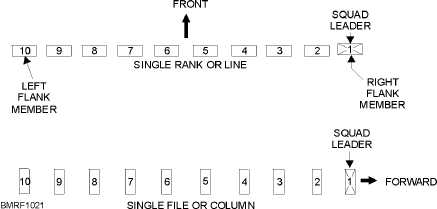One of the purposes for formations is to move a
large number of personnel from one place to another in
an orderly manner. Another purpose is to make sure
people receive correct up-to-date information. People
listen more closely to and better understand what is
being said when they are alert and paying attention. Just
imagine a group of people standing around, their hands
in their pockets, daydreaming or talking while someone
is trying to relay important information. How many
people will actually hear and understand what is being
said? Probably not many! Formations also help teach a
group of individuals to act as members of a team instead
of “doing their own thing.”
POSITIONS WITHIN A FORMATION
Many military functions, such as morning quarters
and personnel inspections, require that you assemble in
formation. The terms used to identify these formations
may vary at different commands. For example, the term
squad or platoon at one command may be a detail,
division, or class at another. Here, the term squad is
used to represent a basic formation. Remember that the
members of any formation must respond in unison
(together) to the commands given. By studying the
following terms and referring to the diagram in figure
10-21, you can easily learn the basic positions within a
formation:
Distance. A space of 40 inches between the chest of one
person and the back of the person ahead within
ranks.
Element. An individual, squad, section, platoon,
company, or some other unit that is part of a larger
unit.
File or column. A formation of elements or persons
placed one behind the other.
Flank. The extreme right or left of a unit, either in line or
in column. The element on the extreme right or left
of the rank. A direction at a right angle to the
direction an element or a formation is facing.
Formation. An arrangement of elements in line, in
column, or in any other prescribed manner.
Guide. The individual on whom a formation or element
regulates its alignment. The guide is usually
positioned to the right.
Interval. The space between individuals from shoulder
to shoulder, normally one arm’s length.
Pace. The length of a full step (30 inches for men and 24
inches for women).
Rank or line. A formation of elements or persons abreast
of each other or side by side.
Step. The distance from heel to heel between the feet of
a marching person. The half step and back step are
15 inches. The right and left steps are 12 inches.
POSITION AND FACING COMMANDS
The two types of commands are the preparatory
command, such as RIGHT, which indicates the type of
movement to be made, and the command of execution,
such as FACE, which causes the desired movement to be
10-32
Student Notes:
Figure 10-21.—Positions within a formation.


